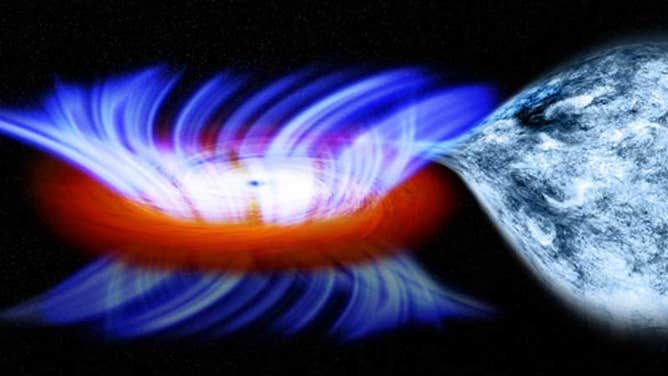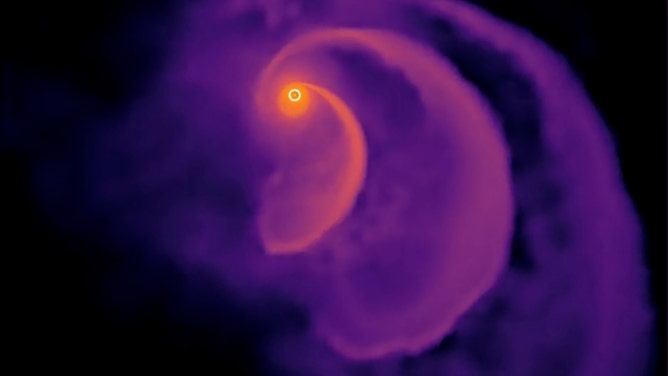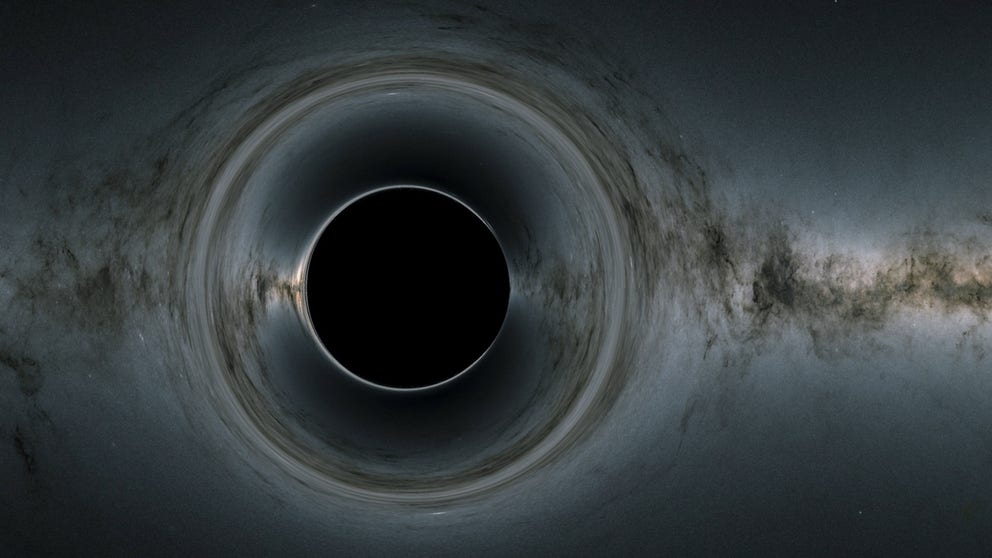Are black holes a danger to us?
The amount of mass a black hole can contain is likened to a star 10 times more massive than our sun squeezed into a sphere about as wide as New York City, according to NASA.
What is a black hole? Explaining the universe's most mysterious cosmic object
Much studied but not fully understood, black holes are among the most mysterious cosmic objects in our universe.
Black holes are some of the most mystifying and terrifying objects in the universe. They have a gravitational pull that is so strong that nothing – not even light, the fastest object – can escape it.
So, do these enigmas of space pose any danger to us on Earth?
What happens inside a black hole?

An artist's impression of how the strong gravity of the black hole, on the left, is pulling gas away from a companion star on the right.
(NASA / CXC / M.Weiss / NASA)
A black hole is a spot that contains a great amount of matter in a very small area. According to NASA, the amount of mass a black hole can contain is likened to a star 10 times more massive than our sun squeezed into a sphere about as wide as New York City.
Scientists cannot directly see inside a black hole, but they can observe the impact of its incredible mass on its surroundings.
PASS THE BIB: WATCH AS STUDY SIMULATES BLACK HOLES EATING GALAXIES LIKE MESSY TODDLERS

Remnants of a wayward star, circling around a black hole.
(Fulya Kıroğlu / Northwestern University / FOX Weather)
For example, NASA said black holes can devour stars, tearing the celestial objects apart as their powerful gravitational field pulls the stars closer. On the flip side, scientists have also observed that black holes can help spur the growth of new stars.
Hypothetically, if a person were to fall inside a black hole, NASA said the individual's perception of space and time would change. Plus, the immense gravity of the black hole would compress you horizontally and stretch you vertically like a noodle, in a phenomenon known as "spaghettification."
How many black holes exist?

In this illustration, light from a smaller black hole (left) curves around a larger black hole and forms an almost-mirror image on the other side. The gravity of a black hole can warp the fabric of space itself, such that light passing close to the black hole will follow a curved path around it.
(Caltech-IPAC / NASA)
The universe is spoiled for choice when it comes to black holes. In our Milky Way galaxy, NASA said there are as many as 10 million to one billion stellar black holes. Remnants of massive stars, these stellar black holes are about 10 to 24 times as massive as our sun.
Much larger than stellar black holes are supermassive black holes. Most galaxies have supermassive black holes at their center. According to the Space Telescope Science Institute, scientists estimate there may be about 100 billion supermassive black holes in our region of the Universe.
Does our galaxy have a black hole at its center?
At the center of our Milky Way galaxy is a supermassive black hole. Called Sagittarius A*, the black hole has a mass of about 4 million sun, according to NASA.
Sagittarius A* is more than 26,000 light years, or 152 quadrillion miles, away from Earth. For context, the entire Milky Way galaxy is about 100,000 light-years across.
NASA said Sagittarius A* is our closest supermassive black hole.
What is the nearest black hole to Earth?

Artist's impression of a runaway supermassive black hole that was ejected from its host galaxy as a result of a tussle between it and two other black holes. As the black hole plows through intergalactic space it compresses tenuous gas in front to it.
(NASA, ESA, Leah Hustak (STScI) / NASA)
Astronomers recently discovered the closest black hole to our home planet.
About 10 times more massive than the sun, the black hole is only about 1,600 light-years away. Located in the constellation Ophiuchus, the black hole is three times closer to Earth than the previous record holder, according to the National Science Foundation.
Scientists said the nearby black hole is a dormant black hole, meaning that it is not actively feeding.
So, can this or any other black hole pose a threat to Earth? Not really. According to NASA, no black hole is close enough to be a danger to us. Plus, the sun is not massive enough to explode to form a black hole.


